- Share
- Share on Facebook
- Share on X
- Share on LinkedIn
Electrokinetic phenomena in confined electrolytes
Élisabeth CHARLAIX, Benjamin CROSS and Romain LHERMEROUT
Liquid electrolytes contain mobile ions in a fluid phase, and therefore exhibit extremely rich transport properties. Thus, a difference in pressure, concentration or electrical potential can generate hydrodynamic, ionic and electrical currents in a coupled manner. These electrokinetic phenomena are crucial for many applications, in particular for osmotic energy recovery.
Models have been proposed several decades ago (such as the Helmholtz-Smoluchowski theory for electro-osmosis in 1921) but they have never been experimentally tested, as it requires to relate the electrokinetic coupling coefficients to the surface properties, both static (surface charge) and dynamic (slip length). We propose to achieve this with a Dynamic Surface Force Apparatus, an instrument that allows precisely the simultaneous measurement of equilibrium and transport properties within an electrolyte, which is confined between solid surfaces with perfectly characterized properties.
Fundings: Total, ANR EDDL, UGA EMIS
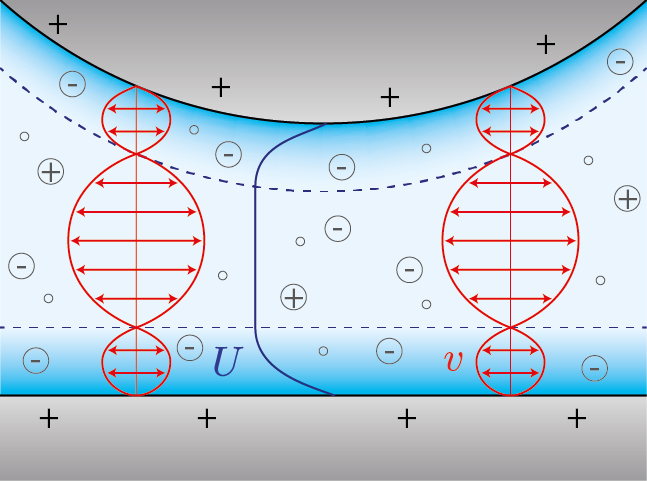
Structure and dynamics of ionic liquids at interfaces
Élisabeth CHARLAIX and Benjamin CROSS
Ionic liquids are pure salts, without solvents, which are liquid at room temperature. They exhibit exceptional bulk physico-chemical properties (high conductivity, very low volatility, non-flammability, large electrochemical window), which make them promising for applications in the energy (batteries, super-capacitors), mechanical (lubrication) and environmental (depollution) fields. All these applications depend on the properties of ionic liquids at interfaces and under confinement and on the link between structure and dynamics, which needs to be better understood.
By measuring the mechanical response of an ionic liquid film with a Dynamic Surface Force Apparatus, we have shown that in the vicinity of an interface ionic liquids organize into ordered layers of molecular size. We have characterized the thickness and elasticity of these layers, and shown that their presence drastically affects the flows of ionic liquids at application-relevant scales.
Nano-mechanics of ionic liquids at dielectric and metallic interfaces
Léo Garcia, Léa Jacquot, Elisabeth Charlaix, Benjamin Cross
Faraday Discussions, 2018, 206, pp.443-457. ⟨10.1039/c7fd00149e⟩
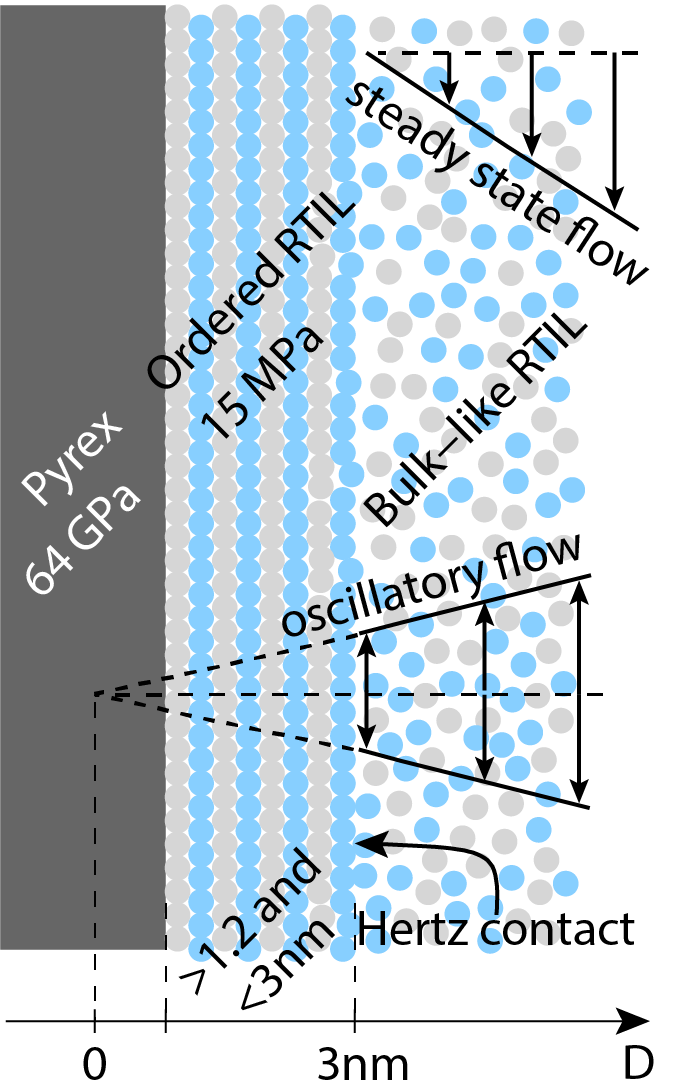
Viscoelasticity and slip of polyelectrolytes
Élisabeth CHARLAIX and Benjamin CROSS
By measuring the nanorheology of polyelectrolyte solutions with a Dynamic Surface Force Apparatus, we have shown that the notion of hydrodynamic slip length is not relevant for viscoelastic fluids. An appropriate description is rather to consider the partial slip boundary condition, as originally formulated by Navier in terms of the interfacial friction coefficient.
In the case of water-soluble polyelectrolytes of high molecular weight, we observed a strong slip when the two confining glass surfaces were separated by at least a few hundred nanometres. By increasing the confinement, we have shown that this slip observed at large distances is in fact only apparent, and due to the presence of a depletion layer of a few tens of nanometres thickness at the solid-solution interface.
Wall slip of complex fluids: Interfacial friction versus slip length
Benjamin Cross, Chloé Barraud, Cyril Picard, Liliane Léger, Frédéric Restagno, Elisabeth Charlaix
Physical Review Fluids, 2018, 3 (6). ⟨10.1103/PhysRevFluids.3.062001⟩
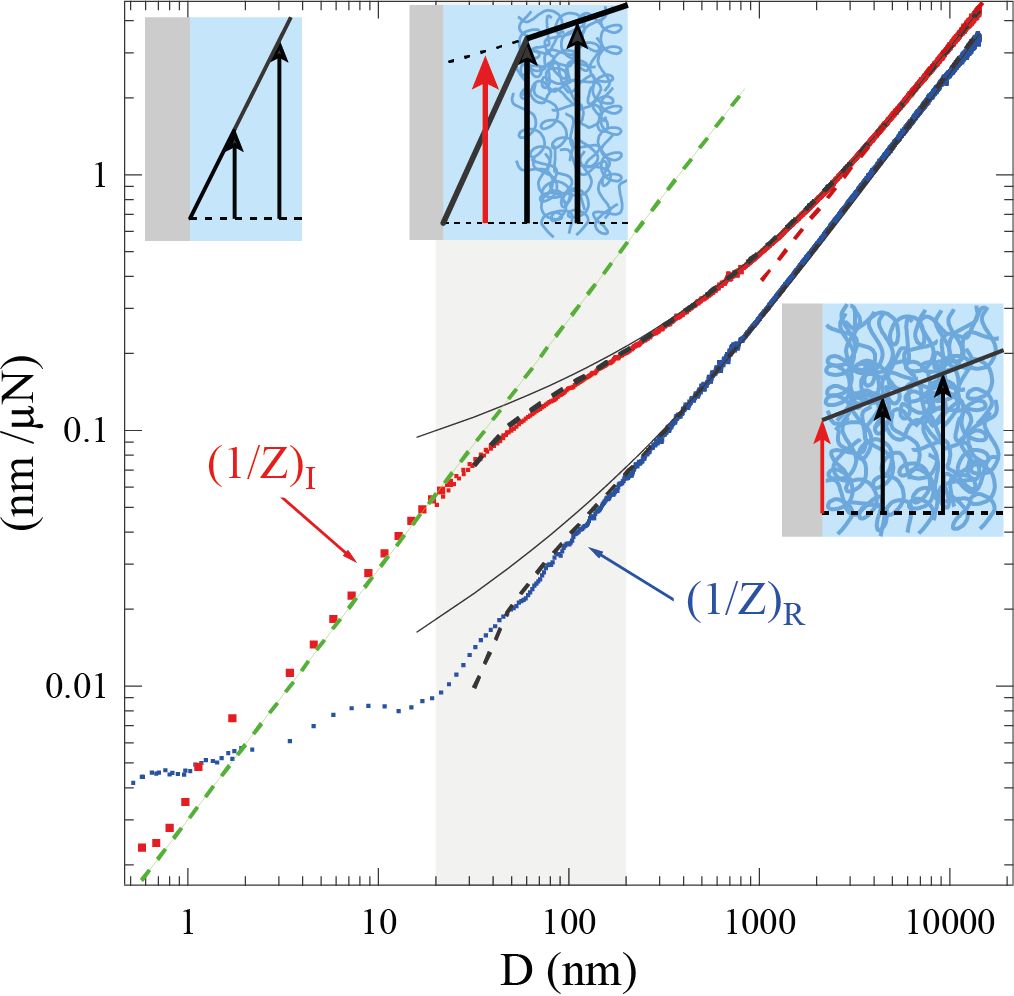
Nanotribology
Lionel BUREAU, in collab. with Gustavo LUENGO (L’Oréal)
We perform nanotribological studies using a home-build Surface Forces Apparatus allowing us to measure the shear properties of nm-thin films of soft materials. Current studies are focused on the tribological behaviour of adsorbed films of polyelectrolytes used in the cosmetic industry.
Funding: L’Oréal
Physico-chemical study of polymer mixtures formed by a polycation and a zwitterionic copolymer in aqueous solution and upon adsorption onto negatively charged surfaces
Laura Fernández-Peña, Eduardo Guzmán, Francisco Ortega, Lionel Bureau, Fabien Leonforte, Dandara Velasco, Ramón Rubio, Gustavo Luengo
Polymer, 2021, 217, pp.123442. ⟨10.1016/j.polymer.2021.123442⟩

Dynamics of frictional sliding
Elsa BAYART
How do solid interfaces break before sliding? This question is central to solid friction mechanics, but also to seismic fault mechanics. Indeed, an earthquake results from the sliding of the two rock faces forming a seismic fault. In the laboratory, we instrument frictional interfaces formed by two solids in contact, in order to study rapid ruptures propagating along the interface. We perform high-frequency strain measurements and particle tracking using fast imaging.
Thanks to this experimental set-up, we have been able to question the role of slow earthquakes - slow slip events occurring along certain portions of faults - on the frequency of earthquake occurrence. We have shown that slow slip acts as a nucleation center for seismic events, thereby increasing the frequency of earthquakes. This work provides a better understanding of how to account for fault complexity in models, and improves our understanding of the diversity of seismic fault behavior.
Experimental evidence of seismic ruptures initiated by aseismic slip
Yohann Faure, Elsa Bayart
Nature Communication, 2024, 15, 8217. ⟨10.1038/s41467-024-52492-2⟩
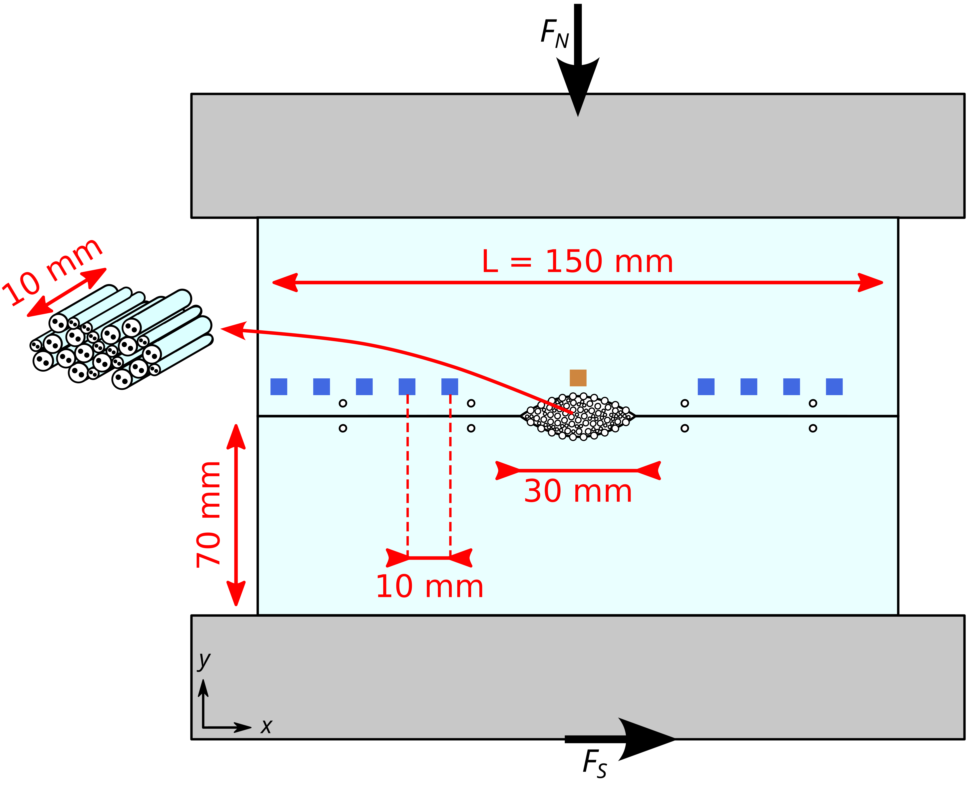
Fractures in cohesive granular materials
Elsa BAYART, in collab. with Simon DAGOIS-BOHY and John SOUNDAR JEROME (Laboratoire de Mécanique des Fluides et d'Acoustique, Lyon)
Cohesive granular materials can fracture on a large scale, a process in which new surfaces are created, unlike dry frictional granular materials. This observation is obvious in the case of a granular medium partially saturated with liquid, where capillary bridges provide cohesion. Less commonly, however, transient ruptures are also observed in dense granular suspensions. The rupture of such media can drastically modify their mechanical strength or permeability properties, and it is essential to understand this phenomenon in order to account for it in models.
We study the mechanisms of fracture formation during impact on partially saturated granular materials, like wet sand, and dense granular suspensions. We are carrying out experiments using laser profilometry to measure the rise of the granular surface, together with rapid imaging. These experiments allow us to elucidate the mechanisms by which these fractures occur.
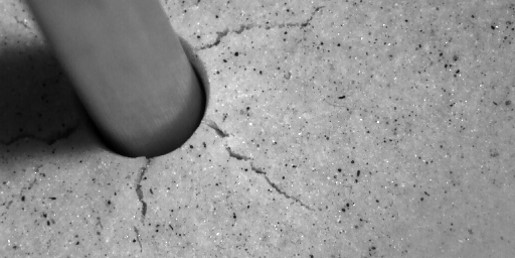
Physics of spray cleaning
Élisabeth CHARLAIX and Élise LORENCEAU, in collab. with Alain CARTELLIER (Laboratoire des Écoulements Géophysiques et Industriels, Grenoble) and Philippe GARNIER (STMicroelectronics)
In many industrial fields, cleaning processes are key steps. These processes must be both efficient and in line with sustainable development. Among these processes, the physics describing the cleaning by impact of an ultra-fast spray on a surface (yet commonly used in the industry and the private sphere) is poorly understood. Thanks to measurements of i) cleaning efficiency of nanoparticle contaminated surfaces performed on state-of-the-art industrial equipment ii) spray characterization and iii) modeling of successive microdroplet impacts, we show that it is the shear in the train of a moving contact line that is responsible for this outstanding efficiency.
Funding: STMicroelectronics
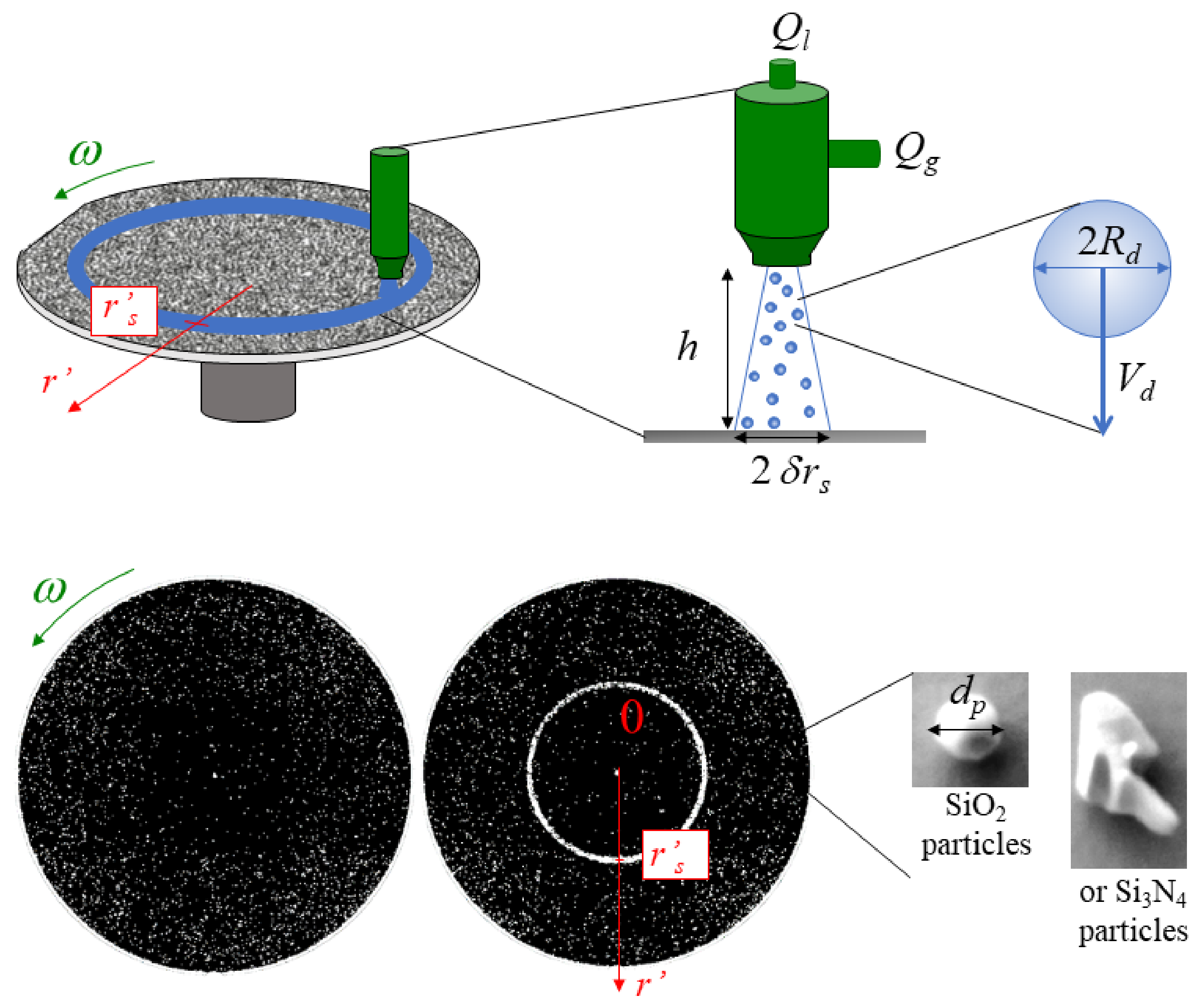
- Share
- Share on Facebook
- Share on X
- Share on LinkedIn